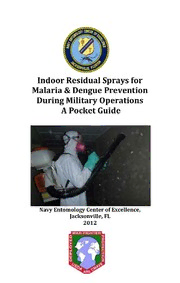
Indoor Residual Sprays for Malaria & Dengue Prevention During Military Operations A Pocket Guide PDF
Preview Indoor Residual Sprays for Malaria & Dengue Prevention During Military Operations A Pocket Guide
Indoor Residual Sprays for Malaria & Dengue Prevention During Military Operations A Pocket Guide Navy Entomology Center of Excellence, Jacksonville, FL 2012 DISCLAIMER Any mention of specific proprietary products, trade names, or manufacturers does not constitute a recommendation or an official endorsement of these products by the Department of Defense but is intended for illustration and information purposes only. Neither should the absence of an item necessarily be interpreted as DoD disapproval. Information or inquiries concerning any equipment or items should be forwarded to your C ommand Pest Management Professional or A pplied Biologist. 1 FOREWORD/ACKNOWLEDGEMENTS This pocket guide (PG) was written to consolidate information and procedures to conduct indoor residual spraying (IRS), reducing the threat of malaria and dengue fever during military operations. This PG outlines safe and effective IRS practices and also provides a list of recommended equipment and insecticides for performing IRS applications. This is not a regulation, but provides guidance to those individuals responsible for conducting pest control during military deployments. This guide will receive periodic review and will be updated to ensure that information presented reflects current technology and policy. 2 TABLE OF CONTENTS 1. Introduction……………………………….………..4 2. Safety………………………………………………...10 3. Personal Protective Equipment…….….…13 4. Chemical Control Equipment………………17 5. Calibration of Equipment……………………20 6. Preparations of Establishment…….……...22 7. Spray Operations……………………………….23 8. Post Spray Operations………………...….......26 9. Guidance…………………………….……….……..28 10. Points of Contact…………….......……………29 11. Appendix A - ……………………………………30 3 1. INTRODUCTION Indoor Residual Spray (IRS) is an insecticide application technique used to protect personnel against nuisance pests and human disease carrying insects (mosquitoes, sand flies, kissing bugs). This technique targets insects that prefer to rest or feed indoors which make contact with the treated surfaces (walls), obtaining a lethal dose of insecticide. IRS has been used extensively in malaria and dengue virus prevention and control programs throughout the world. To be effective, however, it is extremely important to know what mosquitoes are present in your area as IRS applications work against mosquitoes (vectors) known to rest (endophilic) or feed (endophagic) indoors. 4 Malaria Vectors that Rest and/or Feed Indoors Below is a list of malaria vectors known to rest or feed indoors. The map below is a guide that illustrates global distribution of important malaria vectors.A nopheles (spp.) annularis nunez-tovari culicifacies pseudopunctipennis fluviatilis pulicherrimus gambiae sacharvori labranchiae sergenti darlingi stephensi melas subpictus minimus superpictus nili sundaicus 5 Global distribution of the dominant malaria vectors From Kiszewksi et al., 2004 American Journal of Tropical Medicine and Hygiene 70(5): 486-498. 6 Dengue Vectors that Rest or Feed Indoors: Aedes aegypti accounts for > 95% of all dengue virus cases worldwide. It is a small black and white mosquito with a lyre-shaped marking on the back of the thorax. This mosquito species is a daytime biter that readily bites people indoors, resting on wall surfaces after taking a blood meal. It also vectors chikungunya and yellow fever viruses. Aedes aegypti (Photo by CDC) “Lyre” Shape (Alabama Vector Management Society) 7 CDC map showing distribution of Aedes aegypti in yellow and dengue outbreaks in red (for year 2000). 8 Additional Resources for Operational Planning A great resource for determining the risk of vector-borne disease in a particular geographic location is the National Center for Medical Intelligence. Country specific Infectious Disease Risk Assessments can be found on the National Center for Medical Intelligence Website at https://www.intelink.gov/ncmi/index.php. A resource for determining what mosquito species are present in a particular area is the Walter Reed Biosytematics Unit Mosquito Catalog, which can be found at the following website: http://www.mosquitocatalog.org/ and the MosquitoMap found at: http://www.mosquitomap.org/. On-site vector surveillance should also be conducted to validate this information as well as to continually assess entom ological risks. 9
